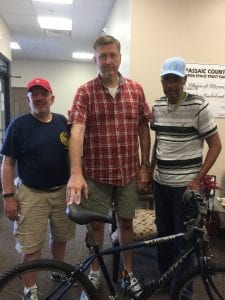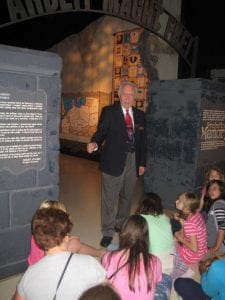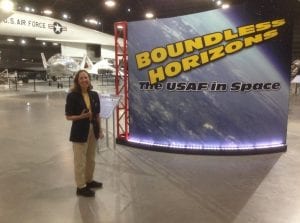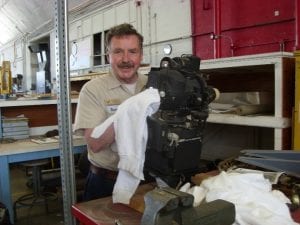By Marc Wolf
From the remote mountains of Afghanistan, to the tip of Japan’s Honshu Island, to the desert sands of Iraq and to London’s urban jungle; I’ve spent much of my adult life far from my family and my hometown of Beaumont, Texas. Through my travels as a U.S. Naval Officer, I’ve learned volumes about myself as well as the different places I have lived and the broad range of people with whom I came in contact.
In my roles as an Anti-Submarine Warfare Intelligence Officer assigned to the Commander of Patrol and Reconnaissance Forces in the FIFTH and SEVENTH Fleets, as well as the Senior Intelligence Officer for Naval Special Warfare’s SEAL Team TWO, I have always led with the Boy Scout Oath and Law as my guide posts. “On my honor, I will do my best.” Those words are the opening lines of the Boy Scout Oath. You see, I grew up as a Boy Scout, earned the Eagle Scout by the age of 15, and those words are the code — let watchword be duty — by which I’d lived my entire life, especially when my own leadership came under fire on my third trip to Afghanistan.
An enlisted man under my charge, but one year my senior, Jesse Harrahill is one of the finest intelligence specialists I ever worked with during my tenure as a commissioned officer in the United States Navy. A true professional with a can-do spirit, a realist who was my sounding board when it was time to think outside the box, a friend and a colleague, Jesse is one of the few people I’ve known who truly “gets it” and whom I would trust to lead in all situations. Jesse understands the big picture. At the time, he’d been doing what he does best for almost ten years and has what it takes to make it in any position in any organization. The Navy is lucky to have him and I was lucky to work with him during the two years I served as the Senior Intelligence Officer assigned to SEAL Team TWO.
The Navy places a significant emphasis on the advancement process. How else do we retain and promote our finest Sailors? The year I met Jesse, he was ten years in and was selected as “Intelligence Specialist of the Year” for the entire Navy. But despite all his accolades, Jesse had still not achieved an important status: Chief Petty Officer. He had one designation to earn before he would make this important career advancement. He hadn’t earned a “Warfare Device.” His best chance would’ve been on a previous tour of duty aboard an aircraft carrier, but he was so busy looking after others, he missed his chance to meet all the requirements and was turned down by the review board.
No matter how other members of the SEAL Team leadership and I argued and appealed, the Navy would not grant an exception for Jesse. So the senior leadership promised Jesse in my presence that we would make it happen — I made that commitment.
We all recognized that moving up to the next level at the senior enlisted ranks was important for Jesse’s personal development and motivation. I knew even more as Jesse had told me this was a goal for himself. I knew that if he didn’t advance he might get out of the service and that would be a great loss.
As Jesse’s superior, I not only had a personal interest in seeing this thru, it was my responsibility as an officer to ensure the integrity of the chain of command. I vowed that under my watch, Jesse would advance.
A month later our situation changed, we had to act fast to take advantage of our enemy’s position and we had to move men into place to be ready. I was sent to another location in Afghanistan; but before I left, I laid out plans for how our manpower should be used. I made it part of my plan to keep Jesse behind. He was just three weeks from reaching his goal – his Warfare Device — and I wanted him to finish. Though Jesse was one of our best, I trusted the other Sailors in my department could complete the mission, and for personal good and the good of the Navy, Jesse was to remain in place. My commanding officer had a different idea.
In the military structure, you don’t question your command. It’s virtually unheard of and carries serious consequences. But I reminded my superiors of the promise they made to Jesse and of how important it was for us to keep that commitment.
I believe a person is defined by his character and the greatest asset he can have is a good name. So, I put myself on the line to help Jesse Harrahill — to help him earn his warfare device and advance to Chief, to help the overall group and to help morale – to let them know they can believe and trust the chain of command and the Navy to take care of them, and to always do the right thing.
In the end, Jesse was able to accomplish his goal. Today he proudly wears the khaki uniform of a Chief, and the Navy and all of us are better for it.
Jesse knew I stood up for him in Afghanistan. He knew I put career and myself on the line. On my last day of active duty service, he honored me with a plaque inscribed with my own words, my mantra: “Always do the right thing and take care of your people no matter what.” He added his own sentiment to the plaque: “It is because of your devotion to this principle that I proudly wear my pin.”
In my life I hope to always remain true to those words — my own words, my own promise and watchword — whether as a supervisor, in management as an executive or as a member of a group taking care of my teammates. It is my hope to always surround myself with people of integrity and honor, who stand up for what’s right, who consider the good of the group, and most importantly, who keep their word, no matter the risk. Words such as these remind me of my sense of duty, honor, purpose, doing what’s right in the most difficult of situations and the importance of looking out for each other, my fellow Sailors and Marines, my comrades-in-arms, my band of brothers. I know I always will.
Volume 71. Number 3. Fall 2017
 along with other veterans-oriented volunteers I attend meetings coordinated by the Catholic Family and Community Services Supportive Services for Veterans and Families (SSVF). David Pearson does a unbelievable job as their Assistant Director of Veterans Services. Last week I received an email from David that a veteran who lives in the Paterson Park Apartments (New Jersey) had been mugged and robbed – both his money and his bicycle had been stolen. For this veteran his bicycle is not recreational, but his primary means of transportation.
along with other veterans-oriented volunteers I attend meetings coordinated by the Catholic Family and Community Services Supportive Services for Veterans and Families (SSVF). David Pearson does a unbelievable job as their Assistant Director of Veterans Services. Last week I received an email from David that a veteran who lives in the Paterson Park Apartments (New Jersey) had been mugged and robbed – both his money and his bicycle had been stolen. For this veteran his bicycle is not recreational, but his primary means of transportation. It would be difficult for any major museum, or other major public attraction for that matter, to function without an army of dedicated volunteers. The National Museum of the U.S. Air Force, located at Wright-Patterson Air Force Base just outside of Dayton, Ohio, is no exception. While visitors will see staff members just about everywhere they venture in the Museum’s four massive buildings, just about all of them are volunteers. From the Information Desk at the entrance to docents stationed at most of the exhibits, and others throughout the complex, most staff that a visitor will see are volunteers.
It would be difficult for any major museum, or other major public attraction for that matter, to function without an army of dedicated volunteers. The National Museum of the U.S. Air Force, located at Wright-Patterson Air Force Base just outside of Dayton, Ohio, is no exception. While visitors will see staff members just about everywhere they venture in the Museum’s four massive buildings, just about all of them are volunteers. From the Information Desk at the entrance to docents stationed at most of the exhibits, and others throughout the complex, most staff that a visitor will see are volunteers. and are ready to answer the m ost-often asked questions from the public (Getting stumped usually results in their researching the question to be better prepared for the next time). Bert always is ready to answer technical questions based on this thirty-six years experience in military aviation R&D. Their duties also include watching for any problems visitors may have and providing assistance or calling in professional staff as needed.
and are ready to answer the m ost-often asked questions from the public (Getting stumped usually results in their researching the question to be better prepared for the next time). Bert always is ready to answer technical questions based on this thirty-six years experience in military aviation R&D. Their duties also include watching for any problems visitors may have and providing assistance or calling in professional staff as needed. Steve Markman, former Post 587 Commander and now Dept of Ohio Commander, volunteers in the Restoration Division. He works out of sight of the public, helping to prepare aircraft for display. For over ten years, Steve has been restoring the historic Memphis Belle. The Memphis Belle was the first U.S. Army Air Forces heavy bomber to return to the U.S. after completing 25 missions over Europe. (The Memphis Belle will go on public display in May of 2018.)
Steve Markman, former Post 587 Commander and now Dept of Ohio Commander, volunteers in the Restoration Division. He works out of sight of the public, helping to prepare aircraft for display. For over ten years, Steve has been restoring the historic Memphis Belle. The Memphis Belle was the first U.S. Army Air Forces heavy bomber to return to the U.S. after completing 25 missions over Europe. (The Memphis Belle will go on public display in May of 2018.)
